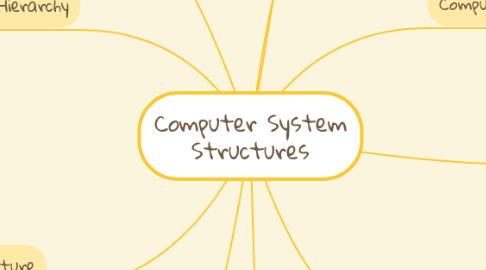
1. Storage Structure
1.1. Main memory
1.1.1. only large storage media that the cpu access directly.
1.1.1.1. loses its contents when power is turned off
1.2. Secondary storage
1.2.1. Extension of main memory that provides nonvolatile storage capacity.
1.2.1.1. capable to hold large quantities of data permanently.
2. Storage Hierarchy
2.1. storage systems are organized in hierarchy
2.1.1. speed
2.1.2. cost
2.1.3. Volatility
2.2. caching
2.2.1. copying information into faster storage system.
2.2.2. main memory can be viewed as last cache for secondary storage.
3. Dual-Mode
3.1. The computer system must be able to distinguish between the execution of os code and user-defined code to ensure the proper execution of the operating system.
3.2. provides hardware support to differentiate between at least two modes of operation.
3.2.1. user mode
3.2.1.1. user program executes in this mode.
3.2.1.2. certain areas of memory are protected from user access.
3.2.2. kernel mode
3.2.2.1. monitor executes kernel mode
3.2.2.2. privileged instructions may be executed.
3.2.2.3. protected areas of memory may be accessed.
3.3. current mode : kernel(0) user(1)
3.4. hardware switches to kernel mode when interrupt or fault occurs.
4. Memory Protection
4.1. .provide memory protection at least for the interrupt vector and the interrupt service routines.
4.2. To have memory protection , two registers are used to determine the range of legal address a program may access.
4.2.1. base register that holds the smallest legal physical memory address.
4.2.2. Limit register that contains the size of the range.
5. I/O protection
5.1. All instructions are privileged and user program cannot issue I/O instructions directly.
6. Interrupt Handling
6.1. When CPU is interrupted , it will immediately stop what is it doing and transfers execution to a fixed location.
7. Synchronous I/O Structure
7.1. After I/O starts , control returns to user program only after I/O completion.
7.1.1. 1.wait instructions idles the cpu until next interrupt. 2.wait loop which is the contention for memory access. 3. at most 1/0 request is outstanding at a time, mo simultaneous processing.
8. Asynchronous I/O Structure
8.1. After I/O starts , control returns to user program without waiting for I/O completion.
8.1.1. System Call : request os to allow user to wait for i/o completion.
8.1.2. Device : contains entry for i/o device indicating its tyoe , address and state.
8.1.3. OS index into I/o device to determine the status and to modify the table entry to include interrupt

